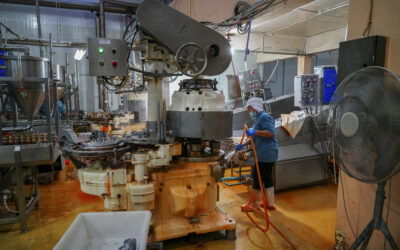The OEE TEEP OOE difference explained simply: Your dashboard shows 72% OEE and you celebrate this performance. But your actual FIT may only be 58%, and your ERR just 34%.
These three indicators: OEE (Overall Equipment Effectiveness), TEEP ((Total Effective Equipment Performance)) and OOE (Overall Operations Effectiveness) measure the performance of your means of production according to three different reference times. Understanding the difference between OEE , TEEP and OOE is essential to any continuous improvement approach.
OEE measures efficiency during planned production time. The TEEP evaluates performance over the entire workshop opening time. OOE reveals your real capacity over 24 hours a day, 7 days a week.
In this article, we decipher these three key performance indicators, their calculation formulas according to the NFE 60-182 standard, and how they reveal hidden losses in your planning process.
Synthetic Rate of Return: Definition and operating performance
OEE (Overall Equipment Effectiveness), is the most widely used performance indicator in industry. It measures the efficiency of a production machine during the planned time only.
The OEE formula combines three components: the availability rate (ratio of operating time to required time), the performance rate (actual production versus nominal output), and the quality rate (good parts to total parts). This method of calculating rates makes it possible to identify precisely where losses occur.
The required time corresponds to the planned time for production, after deduction of planned stoppages such as scheduled preventive maintenance or series changes. This planned cycle time deliberately excludes those stoppages considered “normal”.
Example of OEE rate calculation in production
Let’s take the example of a production line at a TeepTrak customer aeronautics plant. The team works 8 scheduled hours, i.e. 480 minutes. After deducting 30 minutes of planned stoppages, the time required is 450 minutes.
During this day, the line suffered 45 minutes of breakdowns, leaving an effective operating time of 405 minutes. Nominal output is 100 parts per hour. In theory, over 405 minutes, it should produce 675 parts. The actual number of parts produced is 600, of which 570 are compliant.
The calculation gives an availability rate of 90% (405/450), a performance rate of 89% (600/675), a quality rate of 95% (570/600), and a final OEE of 76%, excellent compared with the world standard of 60-65%.
The OEE does not question the duration of planned stoppages, the use of opening hours, or the structural under-utilization of production resources. It answers “Does my machine run well when it’s supposed to?” but not “Should I run it more often?”
Overall yield: Performance over workshop opening time
FIT measures performance over the entire workshop opening time, including planned stoppages, which FIT excludes. This difference in reference time radically changes the perspective.
The OEE is based on the time required (planned production), while the TEEP uses the full opening time without any deductions. If your workshop operates on a two-shift basis (16 hours a day), the FIT measures these 16 full hours. The OEE only measures scheduled production hours.
FIT rate formula and reference time
The TEEP formula is based on the OEE : TEEP = TRS × Load Rate. The load factor is calculated as follows: Required time divided by Opening time. You can also calculate it directly: TEEP = (Required time / Opening time) × 100.
Opening hours correspond to the times when the workshop is open and staff are present (16h in two-shift operation, 24h in three-shift operation).
Let’s go back to our example calculation with an OEE of 76%. The workshop operates on a two-shift basis (960 minutes of opening time). Of these 960 minutes, only 450 were scheduled for production. The rest? Long series changes (2h), preventive maintenance (1h30), meetings, start-ups…
The load factor reaches 450/960 = 47%. The FIT becomes 76% × 47% = 36%. Out of 16 hours of operation, the workshop only really creates value for 5h45.
Losses revealed by the TEEP rate
The TEEP reveals losses invisible in the OEE : series changeovers that take too long (2 hours instead of the 30 minutes possible with SMED), excessive preventive maintenance, shift start-up times (45 minutes), meetings during production hours. These losses are “accepted” in the OEE because they are planned. The TEEP brings them to light and forces us to reconsider what is “planned”.
Economic Efficiency Ratio: Actual capacity over calendar time
OOE measures performance over total calendar time: 24 hours a day, 7 days a week, 365 days a year. OOE is the French equivalent of TEEP (Total Effective Equipment Performance) used in international productive maintenance terminology.
Both measure how much of the total time available is actually being used productively. This measure reveals the untapped potential of your equipment and quantifies the structural under-utilization of your capacities.
Calculation of OOE rate and calendar time
The ERR formula extends the logic: ERR = GRR × Utilization Rate. Utilization rate is calculated: Opening time divided by total calendar time. Calendar time represents 168 hours per week (7 × 24h) or 8,760 hours per year.
With our FIT of 36%, the workshop operates 80 hours a week (16h × 5 days). The weekly calendar time is 168 hours. The utilization rate reaches 80/168 = 48%. The OOE becomes 36% × 48% = 17%.
From 76% (OEE ) to 36% (TEEP) to 17% (OOE). Out of 168 available hours, this line creates value for only 29 hours. The remaining 139 hours (83%) are lost.
The 3 types of losses according to performance indicators
OEE identifies operational losses during planned production time: breakdowns and micro-stops that reduce availability, slowdowns that erode performance, quality defects that consume machine time without creating value.
The TEEP reveals tactical losses, those times “accepted” as incompressible: series changeovers that take too long (2 hours instead of 30 minutes with SMED), excessive preventive maintenance (4 hours instead of 2), excessive ramp-up times (45 minutes per shift).
The OOE highlights the strategic losses linked to organizational choices: absence of night shifts (8 hours lost per day in two-shift operation), weekends not worked (104 days out of 365), capacity-demand mismatches, seasonal stoppages. The ERR quantifies the cost of these organizational choices.
Case study: measurable production results
A plant producing composite materials for the aeronautics industry boasts an OEE of 72%, well above the 60% standard. Yet it regularly turns down orders due to lack of capacity. The general manager is planning to invest 2.8 million in a new line.
TEEPTRAK intervenes with its PerfTrak solution. The audit reveals that the OEE of 72%, although real, masks a different reality. OEE stable at 72%, but TEEP at only 51%. The 21-point gap reveals major tactical losses. ERR collapses to 34%.
Corrective actions include reducing changeovers to 55 minutes with SMED, conditional preventive maintenance, digital handover protocol. Hybrid solution with partial night shift (3 days) + Saturday morning.
Results after 9 months: OEE maintained at 72%, TEEP improved to 67% (+16 points), OOE improved to 56% (+22 points). Production capacity increased by 65% without machine investment. 2.8 million investment deferred for two years.
How TeepTrak measures the 3 levels
TEEPTRAK simultaneously measures OEE , TEEP and OOE without burdening the teams. The PerfTrak solution is based on non-intrusive sensors installed in 2 hours per machine. These sensors automatically collect running times, actual speeds, stops and micro-stops.
The operator simply qualifies the stops via a tablet. This 30-second qualification per event enables the system to automatically distinguish the three levels of loss and calculate OEE , TEEP and OOE in real time.
The dashboard adapts to each user. The operator sees his OEE . The manager monitors the TEEP. The manager analyzes the ERR. A single data source, three reading levels.
Our methodology is graduated: starting with OEE and gradually integrating TEEP and OOE. Phase 1: Stabilize SRT at 65-70%. Phase 2: Reveal RGH and tactical losses. Phase 3: Analyze ERR for strategic decisions.
Conclusion: three complementary indicators
OEE , TEEP and OOE are three complementary ways of looking at the same reality: the utilization of your production capacities. OEE measures efficiency during production. The TEEP reveals how well you use your opening hours. The OOE shows your real 24/7 capacity and informs strategic investment decisions.
At TeepTrak, we have helped more than 120 industrial groups to realize this. The results are consistent: doubling or tripling production capacity without major machine investment.
Want to know your true performance? Contact TeepTrak for a free demo of your three indicators. In less than two weeks, we’ll install our PerfTrak sensors on a pilot line and reveal your real OEE , TEEP and OOE. No obligation, with an average ROI of 6 months.





0 Comments